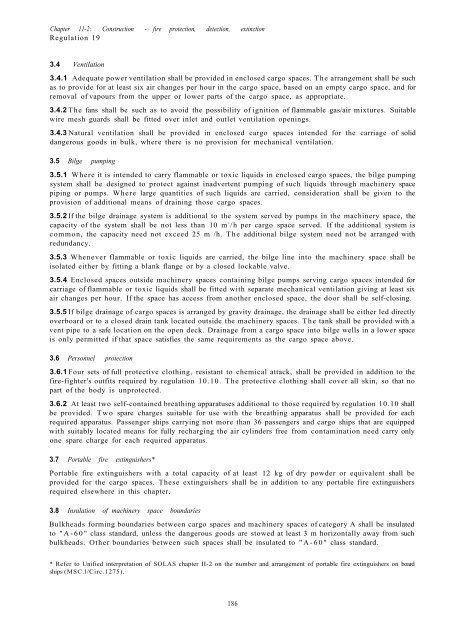Solas Consolidated Edition 2009.pdf
Solas Consolidated Edition 2009 for maritime
Solas Consolidated Edition 2009 for maritime
You also want an ePaper? Increase the reach of your titles
YUMPU automatically turns print PDFs into web optimized ePapers that Google loves.
Chapter 11-2: Construction - fire protection, detection, extinction<br />
Regulation 19<br />
3.4 Ventilation<br />
3.4.1 Adequate power ventilation shall be provided in enclosed cargo spaces. The arrangement shall be such<br />
as to provide for at least six air changes per hour in the cargo space, based on an empty cargo space, and for<br />
removal of vapours from the upper or lower parts of the cargo space, as appropriate.<br />
3.4.2 The fans shall be such as to avoid the possibility of ignition of flammable gas/air mixtures. Suitable<br />
wire mesh guards shall be fitted over inlet and outlet ventilation openings.<br />
3.4.3 Natural ventilation shall be provided in enclosed cargo spaces intended for the carriage of solid<br />
dangerous goods in bulk, where there is no provision for mechanical ventilation.<br />
3.5 Bilge pumping<br />
3.5.1 Where it is intended to carry flammable or toxic liquids in enclosed cargo spaces, the bilge pumping<br />
system shall be designed to protect against inadvertent pumping of such liquids through machinery space<br />
piping or pumps. Where large quantities of such liquids are carried, consideration shall be given to the<br />
provision of additional means of draining those cargo spaces.<br />
3.5.2 If the bilge drainage system is additional to the system served by pumps in the machinery space, the<br />
capacity of the system shall be not less than 10 m 3 /h per cargo space served. If the additional system is<br />
common, the capacity need not exceed 25 m /h. The additional bilge system need not be arranged with<br />
redundancy.<br />
3.5.3 Whenever flammable or toxic liquids are carried, the bilge line into the machinery space shall be<br />
isolated either by fitting a blank flange or by a closed lockable valve.<br />
3.5.4 Enclosed spaces outside machinery spaces containing bilge pumps serving cargo spaces intended for<br />
carriage of flammable or toxic liquids shall be fitted with separate mechanical ventilation giving at least six<br />
air changes per hour. If the space has access from another enclosed space, the door shall be self-closing.<br />
3.5.5 If bilge drainage of cargo spaces is arranged by gravity drainage, the drainage shall be either led directly<br />
overboard or to a closed drain tank located outside the machinery spaces. The tank shall be provided with a<br />
vent pipe to a safe location on the open deck. Drainage from a cargo space into bilge wells in a lower space<br />
is only permitted if that space satisfies the same requirements as the cargo space above.<br />
3.6 Personnel protection<br />
3.6.1 Four sets of full protective clothing, resistant to chemical attack, shall be provided in addition to the<br />
fire-fighter's outfits required by regulation 10.10. The protective clothing shall cover all skin, so that no<br />
part of the body is unprotected.<br />
3.6.2 At least two self-contained breathing apparatuses additional to those required by regulation 10.10 shall<br />
be provided. Two spare charges suitable for use with the breathing apparatus shall be provided for each<br />
required apparatus. Passenger ships carrying not more than 36 passengers and cargo ships that are equipped<br />
with suitably located means for fully recharging the air cylinders free from contamination need carry only<br />
one spare charge for each required apparatus.<br />
3.7 Portable fire extinguishers*<br />
Portable fire extinguishers with a total capacity of at least 12 kg of dry powder or equivalent shall be<br />
provided for the cargo spaces. These extinguishers shall be in addition to any portable fire extinguishers<br />
required elsewhere in this chapter.<br />
3.8 Insulation of machinery space boundaries<br />
Bulkheads forming boundaries between cargo spaces and machinery spaces of category A shall be insulated<br />
to "A-60" class standard, unless the dangerous goods are stowed at least 3 m horizontally away from such<br />
bulkheads. Other boundaries between such spaces shall be insulated to "A-60" class standard.<br />
* Refer to Unified interpretation of SOLAS chapter II-2 on the number and arrangement of portable fire extinguishers on board<br />
ships (MSC.l/Circ.1275).<br />
186


